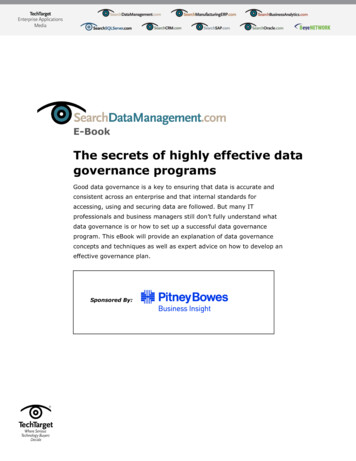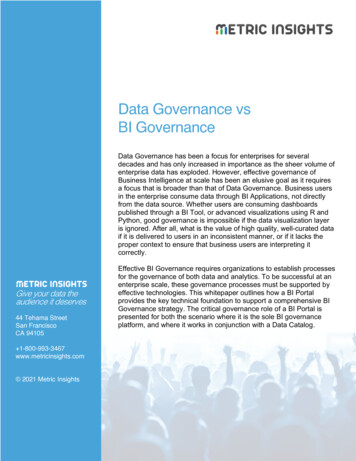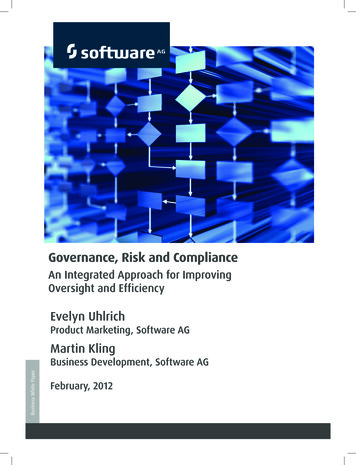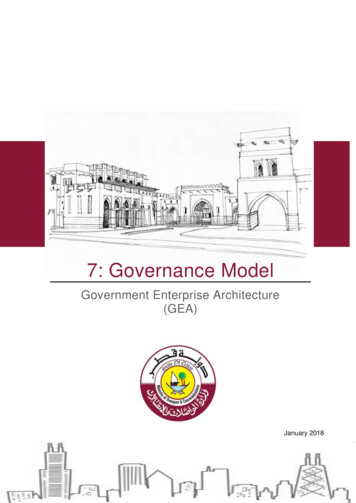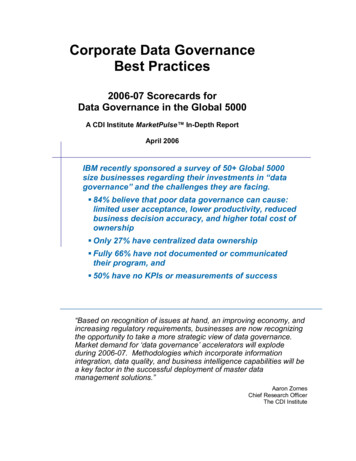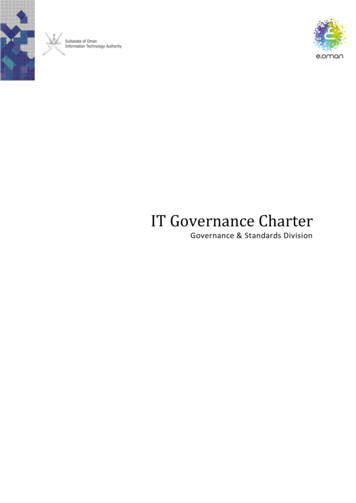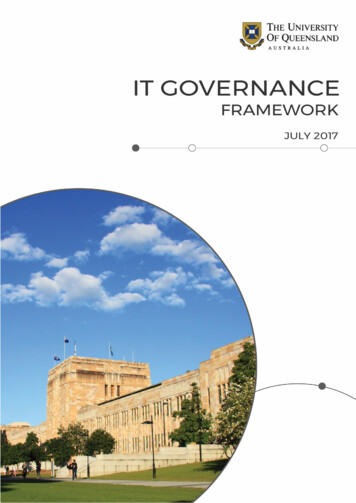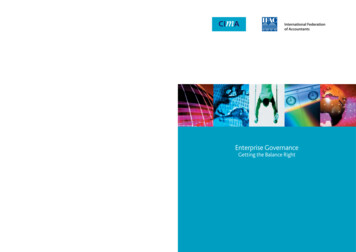
Transcription
Enterprise GovernanceGetting the Balance RightCIMA26 Chapter Street, London SW1P 4NPT 44 (0)20 7663 5441W www.cimaglobal.com
Enterprise GovernanceIFAC is the global organisation for the accountancyprofession. It works with its 159 member organisations in118 countries to protect the public interest by encouraginghigh quality practices by the world’s accountants. IFACmembers represent 2.5 million accountants employed inpublic practice, industry and commerce, government, andacademe.IFAC’s overall mission is to serve the public interest,strengthen the worldwide accountancy profession, andcontribute to the development of strong internationaleconomies.This booklet was prepared by the Professional Accountantsin Business Committee (PAIB) of IFAC. The PAIB Committeeserves IFAC member bodies and the more than one millionprofessional accountants worldwide who work in commerce,industry, the public sector, education, and the not-for-profitsector. Its aim is to enhance the profession by encouragingand facilitating the global development and exchange ofknowledge and best practices. It also works to build publicawareness of the value of professional accountants. The PAIBCommittee was formerly called the Financial andManagement Accounting Committee.The PAIB Committee welcomes any comments you mayhave on this report. Comments should be sent to:PAIB Technical ManagerInternational Federation of Accountants545 Fifth Avenue14th floorNew YorkNew York 10017USAE-mail: robinmathieson@ifac.orgFax: 1 212-286-9570Copies of this report may be downloaded free of chargefrom the IFAC website at www.ifac.org.ISBN: 1-931949-24-7Members of the PAIB Committee, 2003Bill Connell, ChairUKSantiago C LazzatiArgentinaJohn PettyAustraliaGerhard PrachnerAustriaRaymond G DarkeCanadaPatrick RochetFranceEdward K F ChowHong KongSrinivasan RamanathanIndiaAbolghasem FakharianIranRodolfo Di DatoItalyYeo Tek LingMalaysiaPeter A M SampersNetherlandsPichai ChunhavajiraThailandRecep PekdemirTurkeyWilliam L BrowerUSACopyright February 2004 by the International Federation ofAccountants. All rights reserved. With the exception of IFAC memberbodies, no part of this publication may be reproduced, stored in aretrieval system, or transmitted, in any form or by any means,electronic, mechanical, photocopying, recording, or otherwise withoutthe prior written permission of the International Federation ofAccountants. Translation requests should be submitted to IFAC.
1IntroductionThe Professional Accountants in Business Committee (PAIB)of the International Federation of Accountants (IFAC) wasasked by the IFAC Board in October 2002 to explore theemerging concept of enterprise governance. A particularfocus of the project was to consider why corporategovernance often fails in companies and, more importantly,what must be done to ensure that things go right.This report complements an earlier IFAC report, RebuildingPublic Confidence in Financial Reporting: An InternationalPerspective which looked at ways of restoring the credibilityof financial reporting and corporate disclosure. Theinternational perspective distinguishes both these reportsfrom other literature in this field.The PAIB established a steering committee comprisingrepresentatives from five countries: France, Hong Kong, Italy,the United Kingdom and the United States. The members ofthe steering committee are listed on page 2. We undertooka series of case studies covering ten countries and tenmarket sectors. The case studies considered both corporategovernance and strategic issues.This report: defines and explains the concept of enterprise governance; provides a brief summary of the case study findings andidentifies key areas for attention; proposes ways of addressing these priority areas and; introduces the concept of a strategic scorecard.We focus on what goes right and wrong in listed companies.However, most of our recommendations are relevant toother public-interest entities and small and medium-sizedenterprises.The focus is on the processes inside a company. Externalprocesses such as external audit and regulatory complianceare important but they are not covered in this report.In developing this report, we have drawn on a considerablebody of earlier work, particularly in the field of corporategovernance. We have not duplicated this work, but built onit. We emphasise that it is important to balance goodcorporate governance with the creation of sustainable value.A summary of key corporate governance developments isprovided in Appendix 2.Another important feature is that we considered successstories and well-known failures such as Enron andWorldCom. It became very apparent to us that while theheavy emphasis on corporate governance issues has beennecessary in the light of recent scandals, it is important toremember that good governance on its own cannot make acompany successful. Companies need to balanceconformance with performance. This is a fundamentalcomponent of enterprise governance.The Professional Accountants in Business Committee (PAIB) ofIFAC was asked by the IFAC Board in October 2002 to explorethe emerging concept of enterprise governance. A particular focusof the project was to consider why corporate governance oftenfails in companies and, more importantly, what must be done toensure that things go right.
2Enterprise Governance IntroductionThe steering committee is grateful to all those in IFAC’smember bodies who assisted in researching and preparingthe case studies and in particular to Jasmin Harvey, GillianLees and Richard Mallett in the technical department of theChartered Institute of Management Accountants (CIMA)who provided invaluable project management support.Particular thanks also go to Richard Sharman and DavidSmith of KPMG who prepared the section on enterprise riskmanagement.Steering CommitteeUnited Kingdom Bill Connell (Chairman)Richard MallettChartered Institute of ManagementAccountants (CIMA)FrancePatrick RochetAssociation Française des EntreprisesPrivées (AFEP)Hong KongEdward ChowHong Kong Society of Accountants (HKSA)Bill Connell FCMAChairman, IFAC PAIB CommitteeChairman, CIMA Technical CommitteeItalyLuca SavinoConsiglio Nazionale dei Dottori CommercialistiConsiglio Nazionale dei Ragionieri e Periti CommercialiFebruary 2004United StatesPriscilla PayneInstitute of Management Accountants(IMA )This report reflects the personal views of the members ofthe PAIB steering committee and not necessarily the viewsof the organisations of which they are members.
3ContentsExecutive summary41 Context and background92 Principles of enterprise governance103 Case studies134 Strategic oversight205 The CIMA Strategic Scorecard266 Enterprise risk management327 The acquisition process and therisk management process to support it388 Board performance479 Appendices491 Objectives of the project492 Synopsis of international corporate governance developments493 Summary of the case studies534 Case study analysis555 References and further reading57
4Enterprise GovernanceExecutive SummaryThe Professional Accountants in Business Committee (PAIB)of IFAC was asked by the IFAC Board in October 2002 toexplore the emerging concept of enterprise governance. Aparticular focus of the project was to consider whycorporate governance often fails in companies and, moreimportantly, what must be done to ensure that things goright.Scope and focus of workThe scope of our work involved researching the emergingconcept of enterprise governance and developing guidelinesto explain the many facets of this concept. As part of thiswork, we also reviewed recent developments in corporategovernance as well as analysis of what makes strategiessuccessful in companies.Enterprise governance definedThis report defines enterprise governance as “the set ofresponsibilities and practices exercised by the board andexecutive management with the goal of providing strategicdirection, ensuring that objectives are achieved, ascertainingthat risks are managed appropriately and verifying that theorganisation’s resources are used responsibly” (InformationSystems Audit and Control Foundation, 2001).Enterprise governance constitutes the entire accountabilityframework of the organisation. There are two dimensions ofenterprise governance – conformance and performance, thatneed to be in balance.Conformance is also called “corporate governance”. It coversissues such as board structures and roles and executiveremuneration. It has had significant coverage in recent yearsfollowing the various corporate governance scandals andthere will continue to be developments in this area. Codesand/or standards can generally address this dimension withcompliance being subject to assurance/audit. There are alsowell-established oversight mechanisms for the board to useto ensure that good corporate governance processes areeffective eg, audit committees.The performance dimension focuses on strategy and valuecreation. The focus is on helping the board to: make strategicdecisions; understand its appetite for risk and its key driversof performance, and; identify its key points of decisionmaking.This dimension does not lend itself easily to a regime ofstandards and audit. Instead, it is desirable to develop arange of best practice tools and techniques that can beapplied intelligently within different types of organisation.Unlike the conformance dimension, there are, typically, nodedicated oversight mechanisms such as audit committees.In this project we explored whether this “oversight gap” wasa significant issue.At the heart of enterprise governance is the argument thatgood corporate governance on its own cannot make acompany successful. Companies must balance conformancewith performance.Case studiesIn order to test the framework and to explore what goesright or wrong in companies, we chose to undertake a seriesof 27 short international case studies. These were drawnfrom Australia, Canada, France, Hong Kong, Italy, Malaysia,the Netherlands, Thailand, the United Kingdom and theUnited States. A wide range of industries was coveredincluding telecoms, retailing, financial services, energy andmanufacturing.Each case study focused on corporate governance practicesand strategic issues such as the process of strategydevelopment and the resulting choice of strategy. Materialwas drawn from published sources. Our approach was todevelop case studies that were sufficient to generate broadconclusions. The case studies are not intended to bedetailed, rigorous pieces of academic research.Enterprise governance constitutes the entire accountabilityframework of the organisation. There are two dimensions ofenterprise governance – conformance and performance, thatneed to be in balance.
5The material from the case studies was then analysed interms of two categories, each with two subsets as follows: Corporate governance – what went wrong in failure andwhat went right in success. Strategy – what went wrong in failure and what wentright in success.A number of key themes emerged from our analysis.From our findings, we identified priority areas for furtherwork and then focused on developing a series of frameworksand approaches to address these areas. Our aim was toprovide guidelines that would help companies to be moreefficient in their responsibilities for conformance and withvalue creation and use of resources (performance).Principal findings from the case studiesThere were four key corporate governance issues thatunderpinned both success and failure. These were: culture and tone at the top; the chief executive; the board of directors; internal controls.The four key corporate governance factors underlying failurewere interrelated – no single issue dominated. It was alsoapparent that poorly-designed executive remunerationpackages distorted behaviour in the direction of aggressiveearnings management. In extreme cases, when aggressiveearnings targets were not met, fraudulent accounting tendedto occur such as in the cases of Enron, WorldCom, Xerox andAhold.In the cases of success, a virtuous circle emerged based on aconscious decision to take good governance seriouslybecause it was good for the company rather than requiredby law or formal codes of best practice.However, in some cases good governance did not featurestrongly as a key factor of success. This does not imply thatcorporate governance is unimportant for success. Instead, itshows that good corporate governance is a necessary, butnot sufficient, foundation for success. In other words, badgovernance can ruin a company, but cannot, on its own,ensure its success. Enterprise governance, with its focus onboth the conformance and performance aspects of business,ensures that companies do not lose sight of this.Similarly, there were four key strategic issues underlyingsuccess and failure: choice and clarity of strategy; strategy execution; ability to respond to abrupt changes and/or fast-movingmarket conditions; ability to undertake successful mergers and acquisitions(M&A). Unsuccessful M&A was the most significant issuein strategy-related failure.Based on the findings of the case studies, we explored theissue of strategic oversight in more detail. We also identifiedand considered best practice in the following areas, all ofwhich featured strongly in the case studies: enterprise risk management; the acquisition process; board performance.We felt that these were the key priority areas for attention.Strategic oversightAs indicated above, there is no equivalent mechanism to theAudit Committee in the conformance dimension to ensureadequate oversight of the performance or businessdimension. This was supported by the findings of the casestudies where strategic failure was the major issue.
6Enterprise Governance Executive SummaryA particular danger point is at times of transformationalchange when incremental changes in strategy fail to matchthe pace of change in the environment. Organisations canbecome reactive to the environment and fail to question orchallenge what is happening. In the end, an even moreaggressive transformational change may be required – oftenwhen the health of the underlying business has deterioratedconsiderably.Consequently, there is a real need for directors to have atrue and fair view of the strategic position of the company.The fundamental objectives of the ‘Strategic Scorecard’ arethat it: assists the board, particularly the independent directors, inthe oversight of a company’s strategic process; is able to deal with strategic choice and transformationalchange; gives a true and fair view of a company’s strategicposition and progress; tracks actions in, and outputs from, the strategic process –not the detailed content.The scorecard has four basic elements as shown below:One possible way of addressing the strategic oversight gap isthrough the establishment of a strategy committee whichwould undertake regular reviews of strategy and have theright to access external advice if necessary. It should beemphasised that such a committee could only be a“preparatory committee” for the full board which would stillbe responsible for major strategic decisions. The ultimateaim of such a committee would be to better inform the fullboard’s deliberations over strategic decisions.We also concluded that the balanced scorecard, which is arespected performance management tool, could not be usedto fill the strategic oversight gap. Although it is invaluable inhelping businesses to translate agreed strategy into actionand/or to bring non-financial key performance indicatorsinto better focus, it is less successful in addressing theambiguous, uncertain, complex decisions required toformulate the strategy at times of transformational change.The CIMA Strategic ScorecardAs a pragmatic means of addressing the strategic oversightgap, we propose a Strategic Scorecard. This falls somewherebetween the perhaps controversial establishment of astrategy committee and the possibly inappropriate relianceon the balanced scorecard for transformational change. TheStrategic Scorecard is complementary to both theseapproaches.Strategic cImplementationStrategicRisksThe Strategic Scorecard is not a detailed strategic plan. It isaimed at helping the board ensure that all the aspects ofthe strategic process have been completed thoroughly. Ithelps the board to identify the key decision points and thenthe timing of strategic options, milestones in strategicimplementation together with the identification andmitigation of strategic risks.
7We then explored a number of complementary issues thatwould guide companies towards achieving robust corporategovernance (conformance) and strategic success(performance). These are: enterprise risk management; the acquisition process; board performance.Enterprise risk managementA key element of the Strategic Scorecard is consideration ofstrategic risks and this was explored in more detail withinthe framework of enterprise risk management.The role of risk management has historically been aperipheral one in many organisations. However, someorganisations have recognised that the modern businessenvironment, characterised by an ever-increasing pace ofchange, necessitates a more performance-focused approachto risk management.It is this recognition of a performance-driven approach thathas given rise to the concept of enterprise risk management.This reconciles both: the assurance requirements of the board and externalstakeholders ie that the business understands its risks andis managing them actively – conformance – and; the need to better integrate risk management in decisionmaking activity at all levels – performance.A practical framework is presented which pulls together allthe elements required to integrate the management andconsideration of risk with the management of the business.In using the best practice framework, a number of keyinsights have emerged: ignore the change management aspects of riskmanagement at your peril; understand what you have and what you need; risk assessment is a good introduction to riskmanagement; leaders need to lead and to be seen to lead; business strategy and risk strategy need to be aligned.An efficient and effective risk management framework willprovide the board with the information they need todischarge both conformance and performance duties. It willgive them: increased confidence in the organisation’s riskmanagement capability; improved ability at board level to challenge management; improved ability to increase stakeholder confidence thatthe organisation is taking risk management seriously.The acquisition processBecause mergers and acquisitions are notoriously risky ashighlighted by the case studies, particular attention was alsogiven to this topic. Having considered why mergers andacquisitions are different and why they need to be linked tostrategy, a detailed eight-stage process map is presentedwith guidance for each stage. Particular attention is alsogiven to risk management within the acquisition process andto the identification of the responsibilities of the riskmanagement function. A summary of the tools andtechniques to be used by risk professionals is provided. Thefollowing are identified as the key requirements for success: effective, experienced, full-time project management; rigorous evaluation of synergies and ruthlessimplementation; effective due diligence; experienced specialists with recent deal experience; early identification of risks with appropriate mitigatingaction.A key element of the Strategic Scorecard was consideration ofstrategic risks and this was explored in more detail within theframework of enterprise risk management.
8Enterprise Governance Executive SummaryBoard performanceThe final area for detailed consideration relates to boardperformance. New measures that have been introduced invarious countries to strengthen corporate governance havetended to focus on corporate board structures. However,although valuable, such measures do not necessarilyguarantee more effective board performance. Consequently,attention is given to issues such as: performance evaluation for boards including the use ofperformance measurement systems; board dynamics; board design.In general, boards need to ensure that they are making themost effective use of limited time and knowledge in orderto achieve their stated objectives rather than simplycomplying with the letter of corporate governance codes.ConclusionWe believe that the enterprise governance frameworkprovides a timely reminder to organisations to balanceconformance requirements with the need to deliver longterm strategic success through performance.We do not pretend to present a guaranteed formula forbusiness success. However, the case studies highlighted anumber of recurrent themes underlying both success andfailure and there is great value, therefore, in presenting anumber of tools and techniques to address the moreproblematic areas. Greater attention to strategic oversight(through the use of the Strategic Scorecard), enterprise riskmanagement, the acquisition process and boardperformance will go some way towards ensuring effectiveconformance and performance.
91 Context and BackgroundRecent high-profile cases of corporate failure such as Enron,HIH, Tyco, Vivendi, Royal Ahold and, most recently, Parmalathave brought corporate governance to the top of thebusiness and political agenda. This has led to a number ofreviews at national and international level. Appendix 2provides a synopsis of recent international developments incorporate governance.There remains the challenge of ensuring a high minimumstandard of corporate governance internationally. This isbeing addressed by the OECD.The recent IFAC publication, Rebuilding Public Confidence inFinancial Reporting: An International Perspective discusseshow the scandals have led to a loss of credibility in financialreporting and why it is important to restore this credibility.As the report points out: “Reduced confidence in financialinformation and corporate disclosure produces an investorretreat and results in an increased cost of capital. This reducesthe economy’s productivity”. The report considers ways inwhich confidence can be restored and sets out tenrecommendations covering issues such as ethics, auditeffectiveness and accounting and audit standards. Theserecommendations are included in Appendix 2.A recent survey from the Economist Intelligence Unit, showsthat two years after the collapse of Enron, the attentionbeing given to the corporate governance issue is notdiminishing. Over 300 senior managers from around theworld reported that top management is spending more timeon governance now than it did in the previous year andexpect that more time will be devoted to the issue in future.This is in spite of the fact that respondents were unable tosay whether companies are now better governed and that80 per cent felt that governance changes had had no impacton revenues. Still, if asked, all the executives would surelyagree that every effort must be made to prevent the type ofcorporate governance disasters that brought about thecollapse of Enron and WorldCom.It is critical that corporate governance failure is addressedproperly. But there have been other examples of companiesfalling into difficulties as a consequence of their strategicchoices. The effects of such strategic failure can be just asserious for shareholders and for stakeholders in terms of lostjobs, pensions and savings. There is a danger that in thelaudable attempt to improve standards of control and ethics,insufficient attention is paid to the need for companies tocreate wealth and to ensure that they are pursuing the rightstrategies to achieve this.Burwell and Mankins have argued that “overlookingmanagement improprieties is not the only way boards havelet down shareholders in recent years”. They cite a numberof examples including Ford, Kmart, Vivendi and Nortel whereboards have failed to steer management away fromdecisions that damaged long-term shareholder value.There is a growing body of popular business literature thatattempts to discover the secrets of sustainable businesssuccess. Recent examples include Good to Great by JimCollins and What Really Works by William Joyce, Nitin Nohriaand Bruce Roberson. Both devote considerable attention tostrategic issues but give only brief consideration oftraditional corporate governance. There is little coverage ofthe potentially conflicting demands on boards to ensurethat both the conformance and performance aspects ofrunning the business are addressed adequately and thatthere is a healthy balance between the two.There is a gulf between the corporate governance agendaand the “business success” literature and a framework isrequired to bring these two together. This framework isenterprise governance.Recent high-profile cases of corporate failure such as Enron, HIH,Tyco, Vivendi, Royal Ahold and, most recently, Parmalat havebrought corporate governance to the top of the business andpolitical agenda.
10Enterprise Governance2 Principles of Enterprise GovernanceEnterprise governance is an emerging term which describes aframework covering both the corporate governance and thebusiness governance aspects of an organisation. Achieving apanacea of good corporate governance that is linkedstrategically with performance management will enablecompanies to focus on the key drivers that move theirbusiness forward. This is both a challenge and anopportunity.As indicated in Appendix 2, much work has been carried outrecently on corporate governance. But the performanceaspects of governance have not received so much attention.Enterprise governance considers the whole picture to ensurethat strategic goals are aligned and good management isachieved. It may help to demonstrate the importance of thedifferent emphasis of the roles of the chairman and chiefexecutive officer (CEO) – and therefore why they need tobe split. It helps to illustrate the multiple roles of the accountant. It can demonstrate the importance of substance overform. It can accommodate the different governance modelsacross the world.Figure 1: The enterprise governance frameworkENTERPRISE GOVERNANCEWhat is enterprise governance?Research has revealed a number of possible definitions ofenterprise governance.The definition chosen by this report as its starting pointdefines enterprise governance as “the set of responsibilitiesand practices exercised by the board and executivemanagement with the goal of providing strategic direction,ensuring that objectives are achieved, ascertaining that risksare managed appropriately and verifying that theorganisation’s resources are used responsibly” (InformationSystems Audit and Control Foundation, 2001).This holistic definition has several benefits. It reflects the dual role of the board of directors in bothmonitoring and strategy, and acknowledges the inherentshort and long term tensions between governance andvalue creation. It emphasises the role of the executive managementteam. It covers the internal workings of the organisation as wellas the outward facing aspects.Corporate Governancei.e. ConformanceBusiness Governancei.e. PerformanceAccountabilityAssuranceValue CreationResource UtilisationFigure 1, above, illustrates the reach of enterprisegovernance – it constitutes the entire accountabilityframework of an organisation. In general, the conformancedimension takes an historic view while the performanceview is forward-looking. It makes it clear that goodcorporate governance is only part of the story – strategy isalso important.Enterprise governance considers the whole picture to ensure thatstrategic goals are aligned and good management is achieved.
11The diagram is similar to the one that illustrates the domainof the finance function in a recent comprehensive study oncompetencies (PAIB, 2002). This indicated that the overalldomain of the finance function incorporated corporategovernance responsibilities and making a contribution tovalue creation and business success. The lines show that,although conformance feeds directly to accountability andperformance to value creation, conformance can also feed tovalue creation while performance can feed to assurance.The conformance dimension sits on the left hand side of theillustration which seems highly appropriate given that this isthe side of the brain that governs our logical, orderly andanalytical functions while right brain thinking tends to beintuitive, holistic and creative!The conformance dimensionThe conformance dimension of enterprise governance hashad significant coverage in recent years and, in particular, inthe last two years following the various corporate scandals.It is normally called “corporate governance” and coversissues such as: the roles of the chairman and CEO; the board of directors, eg, composition, non-executivedirectors, training etc; board committees eg, audit, remuneration andnominations committees; internal controls in an organisation; risk management and internal audit; executive remuneration.It is well covered in the literature and there will continue tobe developments in this area. Codes and/or standards cangenerally address this dimension with compliance beingsubject to assurance/audit.Within the conformance dimension, the role of theprofessional accountant in business is that of control toensure accountability; and of internal audit to assure thatthe controls are effective.The primary role of the external auditors is to give anindependent opinion on the truth and fairness of thefinancial statements of the enterprise. Depending on thejurisdiction in which the enterprise is based, they may alsobe required to give an independent opinion on theenterprise’s compliance with certain requirements of the lawand regulations. In fulfilling their role, the external auditorswill work closely with those charged with the governance ofthe enter
Fax: 1 212-286-9570 Copies of this report may be downloaded free of charge from the IFAC website at www.ifac.org. ISBN: 1-931949-24-7 . Enterprise governance constitutes the entire accountability framework of the organisation. There are two dimensions of enterprise governance - conformance and performance, that


